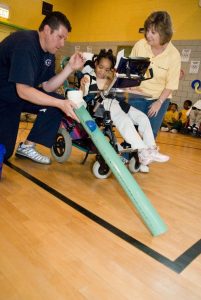Recently, my two sons had their first swim meet. One won first in backstroke and the other got second in freestyle. Although they both did well, it was something special that caught my eye during the competition.
One young man on our swim team has cerebral palsy. In fact, we have multiple swimmers with a variety of needs, and these individuals are never turned away. They’re celebrated.
In this age of either singing “We Are the Champions” or oppositely handing every participant a ribbon, the swim team my boys swim on finds the perfect balance. This team of inclusion has a focus on being the best swimmers, but without sacrificing having the best character.

Changing the Game
While it seems obvious that as teachers we should be inclusive of all students, this tends to go out the window when we are faced with grading systems, testing outcomes, and zealous parents. We look for options that make classes and schools run smoother at the loss of truly finding what each student really needs to be successful. For students to be prepared for a changing world, we need to be inclusive of all students and their abilities.
The STEM program that I run focuses on three characteristics of developing excellence in students: autonomy, mastery and purpose. Developed by Daniel Pink for motivating employees, I have taken his advice and applied it to creating successful students. This has led me to develop a classroom of inclusion, using techniques pertaining to the development of the purpose characteristic.
When students come to my class, I want them to find a purpose, excel, and then exploit it. STEM gives me the perfect platform for accomplishing this task. The problem-solving base of the program allows students to discover solutions using any means possible. Instead of a class that is solely focused on academia, students can explore problems and come up with solutions. Students in my class can fabricate their solutions to better understand the processes that go into developing an idea. This allows for a completely different aspect of learning and demonstrating knowledge.
How STEM Helps
A few years back, I had a student who had problems both behaviorally and academically in class. When constructing projects, he was key to the success because of his ability to use his hands to deconstruct something and then rebuild it. His understanding of the tools, and groups that worked with him, gave him an advantage that students quickly took note of. Through this exploration of projects pertaining to experiences where he was able to add value, he developed an appreciation to increase his academic success while improving behavior. Other students also realized that when you employ a skill that you are confident of, others take notice. Finding success through multiple avenues increases student engagement and creates a culture of belonging in a classroom.
Be The Change
Building upon successes like these, I have increased a push for our school to become a school of inclusion, where all students are appreciated for their unique talents. We can seize a golden opportunity for students to learn in a rich environment where they share experiences with one another.
In the STEM classroom, there are many avenues to explore how to find the purpose of each student and show them a path that can fundamentally change the culture of a class. Take time to find the value in each student. Notice how they can impact classroom culture through the gifts that they bring, no matter how big or small. The rewards are endless and will grow a community where no project is too big for you and your students to overcome.







Leave A Comment